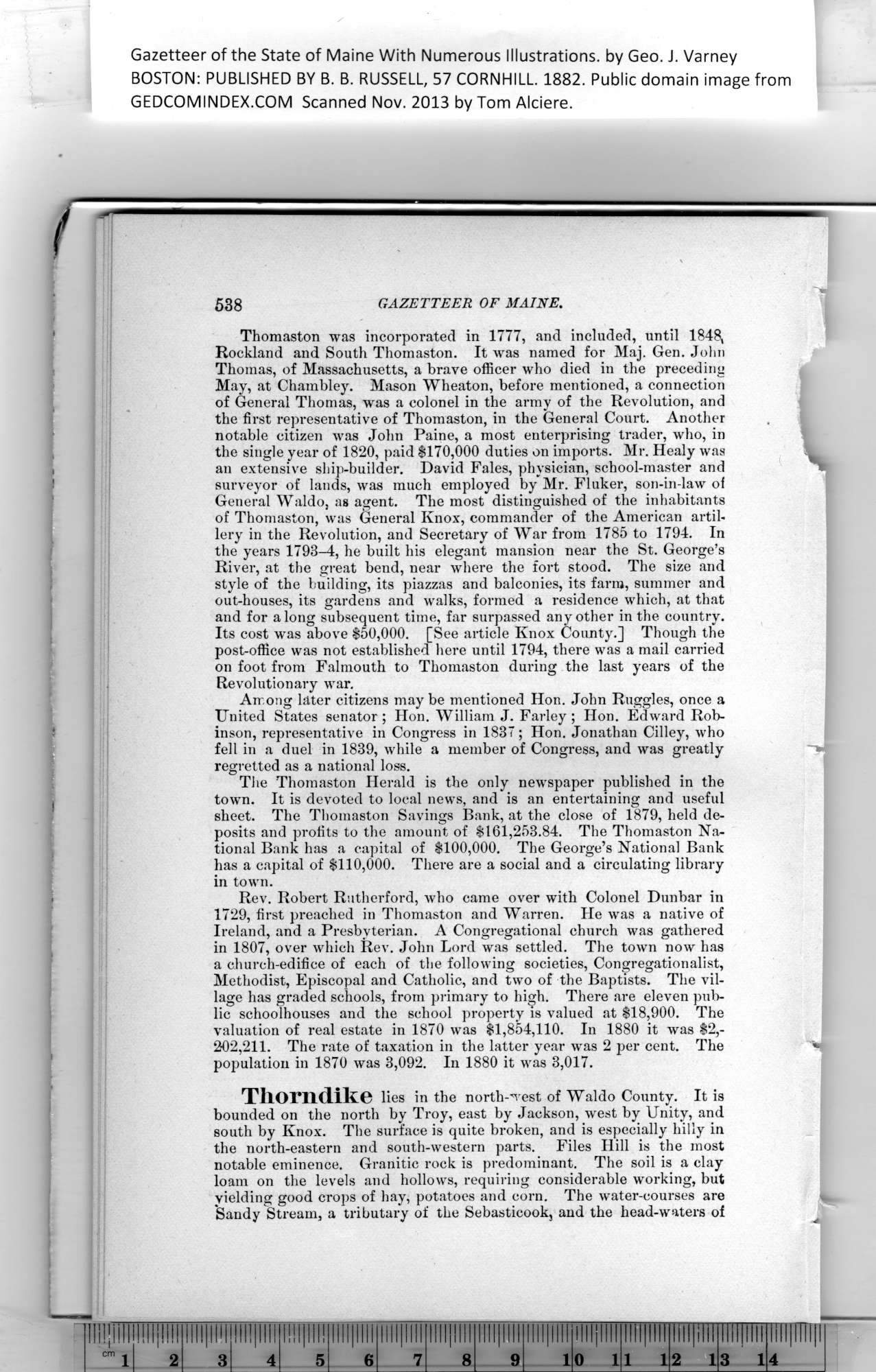|
Gazetteer of the State of Maine With Numerous Illustrations, by Geo. J. Varney
BOSTON: PUBLISHED BY B. B. RUSSELL, 57 CORNHILL. 1882. Public domain image from
538 GAZETTEER OF MAINE.
Thomaston was incorporated in 1777, and included, until 1848,
Rockland and South Thomaston. It was named for Maj. Gen. John
Thomas, of Massachusetts, a brave officer who died in the preceding
May, at Chambley. Mason Wheaton, before mentioned, a connection
of General Thomas, was a colonel in the army of the Revolution, and
the first representative of Thomaston, in the General Court. Another
notable citizen was John Paine, a most enterprising trader, who, in
the single year of 1820, paid $170,000 duties on imports. Mr. Healy was
an extensive ship-builder. David Fales, physician, school-master and
surveyor of lands, was much employed by Mr. Fluker, son-in-law of
General Waldo, as agent. The most distinguished of the inhabitants
of Thomaston, was General Knox, commander of the American artil-
lery in the Revolution, and Secretary of War from 1785 to 1794. In
the years 1793-4, he built his elegant mansion near the St. George’s
River, at the great bend, near where the fort stood. The size and
style of the building, its piazzas and balconies, its farm, summer and
out-houses, its gardens and walks, formed a residence which, at that
and for along subsequent time, far surpassed any other in the country.
Its cost was above $50,000. [See article Knox County.] Though the
post-office was not established here until 1794, there was a mail carried
on foot from Falmouth to Thomaston during the last years of the
Revolutionary war.
Among later citizens maybe mentioned Hon. John Ruggles, once a
United States senator; Hon. William J. Farley; Hon. Edward Rob-
inson, representative in Congress in 1837; Hon. Jonathan Cilley, who
fell in a duel in 1839, while a member of Congress, and was greatly
regretted as a national loss.
The Thomaston Herald is the only newspaper published in the
town. It is devoted to local news, and is an entertaining and useful
sheet. The Thomaston Savings Bank, at the close of 1879, held de-
posits and profits to the amount of $161,253.84. The Thomaston Na-
tional Bank has a capital of $100,000. The George’s National Bank
has a capital of $110,000. There are a social and a circulating library
in town.
Rev. Robert Rutherford, who came over with Colonel Dunbar in
1729, first preached in Thomaston and Warren. He was a native of
Ireland, and a Presbyterian. A Congregational church was gathered
in 1807, over which Rev. John Lord was settled. The town now has
a church-edifice of each of the following societies, Congregationalist,
Methodist, Episcopal and Catholic, and two of the Baptists. The vil-
lage has graded schools, from primary to high. There are eleven pub-
lic schoolhouses and the school property is valued at $18,900. The
valuation of real estate in 1870 was $1,854,110. In 1880 it was $2,-
202,211. The rate of taxation in the latter year was 2 per cent. The
population in 1870 was 3,092. In 1880 it was 3,017.
Thorndike lies in the north-west of Waldo County. It is
bounded on the north by Troy, east by Jackson, west by Unity, and
south by Knox. Tbe surface is quite broken, and is especially billy in
the north-eastern and south-western parts. Files Hill is the most
notable eminence. Granitic rock is predominant. The soil is a clay
loam on the levels and hollows, requiring considerable working, but
yielding good crops of hay, potatoes and corn. The water-courses are
Sandy Stream, a tributary of the Sebasticook, and the head-waters of
PREVIOUS PAGE ... NEXT PAGE
This page was written in HTML using a program written in Python 3.2
|
